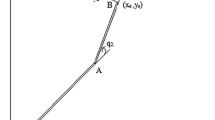Abstract
In this paper a method for solving the inverse kinematics of an humanoid robot based on artificial neural networks is presented. The input of the network is the desired positions and orientations of one foot with respect to the other foot. The output is the joint coordinates that make it possible to reach the goal configuration of the robot leg. To get a good set of sample data to train the neural network the direct kinematics of the robot needs to be developed, so to formulate the relationship between the joint variables and the position and orientation of the robot. Once this goal has been achieved, we need to establish the criteria we are going to use to choose from the range of possible joint configurations that fit with a particular foot position of the robot. These criteria will be used to filter all the possible configurations and retain the ones that make the robot configurations more stable in the training set.
Access this chapter
Tax calculation will be finalised at checkout
Purchases are for personal use only
Preview
Unable to display preview. Download preview PDF.
Similar content being viewed by others
References
Vukobratovic M., Brovac, B., Surla, D., Sotkic, D. (1990) Biped Locomotion. Springer-Verlag, Berlin
Huang, Q. Yokoi, K., Kajita, S., Kaneko, K., Arai, H., Koyachi, N., Tanie, K. (2001) Planning walking patterns for a biped robot. IEEE Trans. on Robotics and Automation, 17(3), 280–289
Furuta, T., Tawara, T., Okumura, Y., Shimizu M., Tomiyama, K. (2001) Design and construction of a series of compact humanoid robots and development of biped walk control strategies. Robotics and Autonomous Systems, 37(2–3), 81–100
De Lope, J., González-Careaga, R., Zarraonandia, T., Maravall, D. (2003) Inverse kinematics for humanoid robots using artificial neural networks, EUROCAST 2003, Proc. of Intl. Workshop on Computer Aided Systems Theory, 216–218
Ossoining, H., Reisinger, E., Steger, C., Weiss, R. (1996) Design and FPGA-Implementation of a Neural Network, Proc. of the 7th Int. Conf. on Signal Processing Applications & Technology, 939–943
Martinetz, T.M., Ritter, H.J., Schulten, K.J. (1990) Three-dimensional neural net for learning visuomotor coordination of a robot arm. IEEE Trans. on Neural Networks, 1(1), 131–136
Jordan, M.I., Rumelhart, D.E. (1992) Forward models: Supervised learning with a distal teacher. Cognitive Science, 16, 307–354
Xia, Y., Wang, J. (2001) A dual network for kinematic control of redundant robot manipulator. IEEE Trans. ond Systems, Man, and Cybernetics—Part B: Cybernetics, 31(1), 147–154
Kurematsu, Y., Maeda, T., Kitamura, S. (1993) Autonomous trajectory generation of a biped locomotive robot. IEEE Int. Conf. on Neural Networks, 1961–1966
Yamasaki, F., Miyashita, T., Matsui, T., Kitano, H. (2000) PINO, The humanoid that walk, Proc. of The First IEEE-RAS Int. Conf. on Humanoid Robots, MIT
Endo, K., Maeno, T., Kitano, H. (2002) Co-evolution of Morphology and Walking Pattern of Biped Humanoid Robot using Evolutionary Computation—Consideration of characteristic of the servomotors-, IEEE/RSJ Int. Conf. on Intelligent Robots and Systems, 2678–2683
Author information
Authors and Affiliations
Editor information
Editors and Affiliations
Rights and permissions
Copyright information
© 2003 Springer-Verlag Berlin Heidelberg
About this paper
Cite this paper
de Lope, J., Zarraonandia, T., González-Careaga, R., Maravall, D. (2003). Solving the Inverse Kinematics in Humanoid Robots: A Neural Approach. In: Mira, J., Álvarez, J.R. (eds) Artificial Neural Nets Problem Solving Methods. IWANN 2003. Lecture Notes in Computer Science, vol 2687. Springer, Berlin, Heidelberg. https://doi.org/10.1007/3-540-44869-1_23
Download citation
DOI: https://doi.org/10.1007/3-540-44869-1_23
Published:
Publisher Name: Springer, Berlin, Heidelberg
Print ISBN: 978-3-540-40211-4
Online ISBN: 978-3-540-44869-3
eBook Packages: Springer Book Archive




